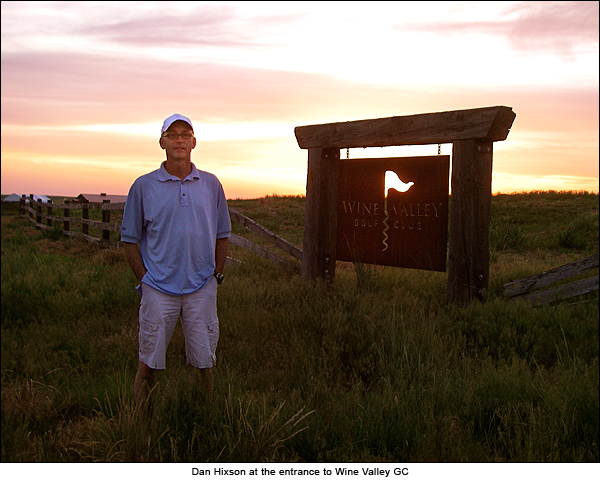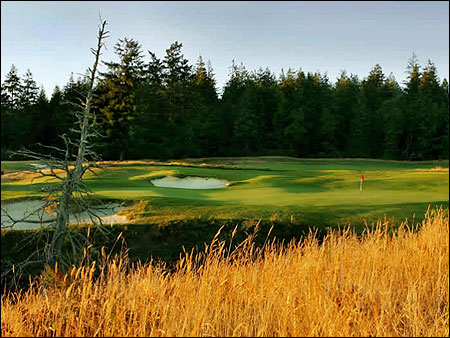A Little Native Ability

Self-taught Dan Hixson has quietly become one of the region’s best course designers
by Blaine Newnham
Dan Hixson, perhaps the most celebrated new golf architect in the country, is supremely self-taught. Not only didn’t he study as a golf architect, but never worked for one either.
After just two full-fledged course designs – Bandon Crossings on the Southern Oregon coast, and Wine Valley Golf Club in Walla Walla, Wash. – Hixson is not only a nationally-recognized designer, but may well be an heir to great Northwest designers, following in the footsteps of A.V. Macan, Chandler Egan, Bunny Mason, John Fought, Bill Robinson, Bill Overdorf, John Steidel and John Harbottle.
Sculpted in the waving wheat country of Southeast Washington, Wine Valley, which opened in 2009, has recently been included in a top 100 list of America’s best modern designs, ahead of courses like Hazeltine and Valhalla, former sites of major championships.
Hixson is presently working on a 27-hole course in Eastern Oregon called Silvies Valley Ranch, near the town of John Day. Indeed, he’s building a course when only 10 new golf course projects are underway in the entire U.S.
So who is Dan Hixson, and how did he get there?
“When I was a kid my mom said she’d see the light on in my room late at night and she was sure I was drawing golf holes,” he said.
The dream never forgot Hixson. He followed in his dad’s footsteps – Harvey was a PGA club pro in Cottage Grove, Ore. – working for 12 years at Columbia Edgewater in Portland, eventually becoming that club’s PGA head pro. He was good enough as a player to do a mini-tour stint in Australia and New Zealand.
But there remained this burning desire to design courses. He said the dream first sparked in the late 1960s when his dad took him to watch Robert Trent Jones’ remaking of nearby Eugene Country Club, where his grandparents were members.
Dan Hixson was seven.
“The art side was always there,” he said. “I was constantly drawing. I designed furniture. I kept track of the great golf holes I had seen. I was particularly taken by the Alister MacKenzie work in Australia. I liked the natural look of the bunkers.”
His schooling for course design came during the failed attempt to play golf for a living, but also during his successful tenure as a teaching pro. He understood the average golfer, and, more than anything, he understood golf as a business.

“I wasn’t afraid,” he said, “to tell clients they couldn’t spend $8 million and have the project be successful.”He knew courses built in the 1980s and ’90s moved too much dirt, cost too much to build and maintain, and were, in some instances, destined to fail.
But how do you get started as an architect when you’ve never even worked with one?
For Hixson, it came one hole at a time. He built a short-game practice area and par-3 course at Columbia Edgewater. He built greens here and tees there. He helped with a remodel at Emerald Valley near Eugene, and did a smart nine-hole revision at the Crestview course in Waldport, Ore.
For Hixson, the move to a career in design was as much personal as it was professional. He left Columbia Edgewater, got divorced, downscaled and began a career devoted to being an architect even if he weren’t one.
He sought the advice of other architects. Harbottle told him to find people who wanted to build a golf course, and build it for them.
“I would have done Bandon Crossings for nothing,” he said.
Indeed, it was the gamble a couple from Eugene – Rex and Carla Smith – took on Hixson to build Bandon Crossings that realized the dream.
“I wasn’t remotely qualified for the job,” said Hixson. “But I said to them, ‘Let me come down and we’ll talk.'”
They shook hands on a deal a few hours later.
“I told them I knew how important the project was to them – they were putting their life savings on the line – but that it was more important to me,” he said.
Unlike a big-name architect who might visit a job a couple times a week, Hixson lived at Crossings during the week and said in the end made 47 trips between Portland and Bandon.
“I’d be home to water the plants and that was about it,” he said.
He would show the same kind of fanatical commitment at Wine Valley, working with strong golf construction folks who would supply the technical expertise Hixson was lacking.
Hixson was never too proud or vain to ask for help.
He had former PGA Tour pro Bob Goalby’s son, Kye, do the shaping at Wine Valley.
“Dan was not rigid in his ideals and allowed me to improvise and create a lot of greens and features,” Goalby said in an interview with GolfClubAtlas.com, the insider’s course architecture website.
Goalby, in fact, was a big part of developing the Wine Valley bunker style, inspired by road cuts he’d seen driving to the construction site.
Some of the critical acclaim for Hixson’s work comes from Mike Goldsberry, the superintendent at Wing Point G&CC on Bainbridge Island, Wash. who played Wine Valley as a participant in the Northwest Open.
“Plain and simple,” said Goldsberry in an email, “Wine Valley is a blueprint for golf course design. It is a superintendent’s dream. Ninety percent of the course is fairway height, the bunkers are raw with very little maintenance and the grass heights are managed with very few mowers.”
Hixson still rides a mower at Wine Valley, relaxing while he imagines how he can make his next course even easier to maintain and at the time more enjoyable to play.
Genius at work.
A former columnist for the Eugene Register-Guard and the Seattle Times, Blaine Newnham has played a few Hixson designs.





